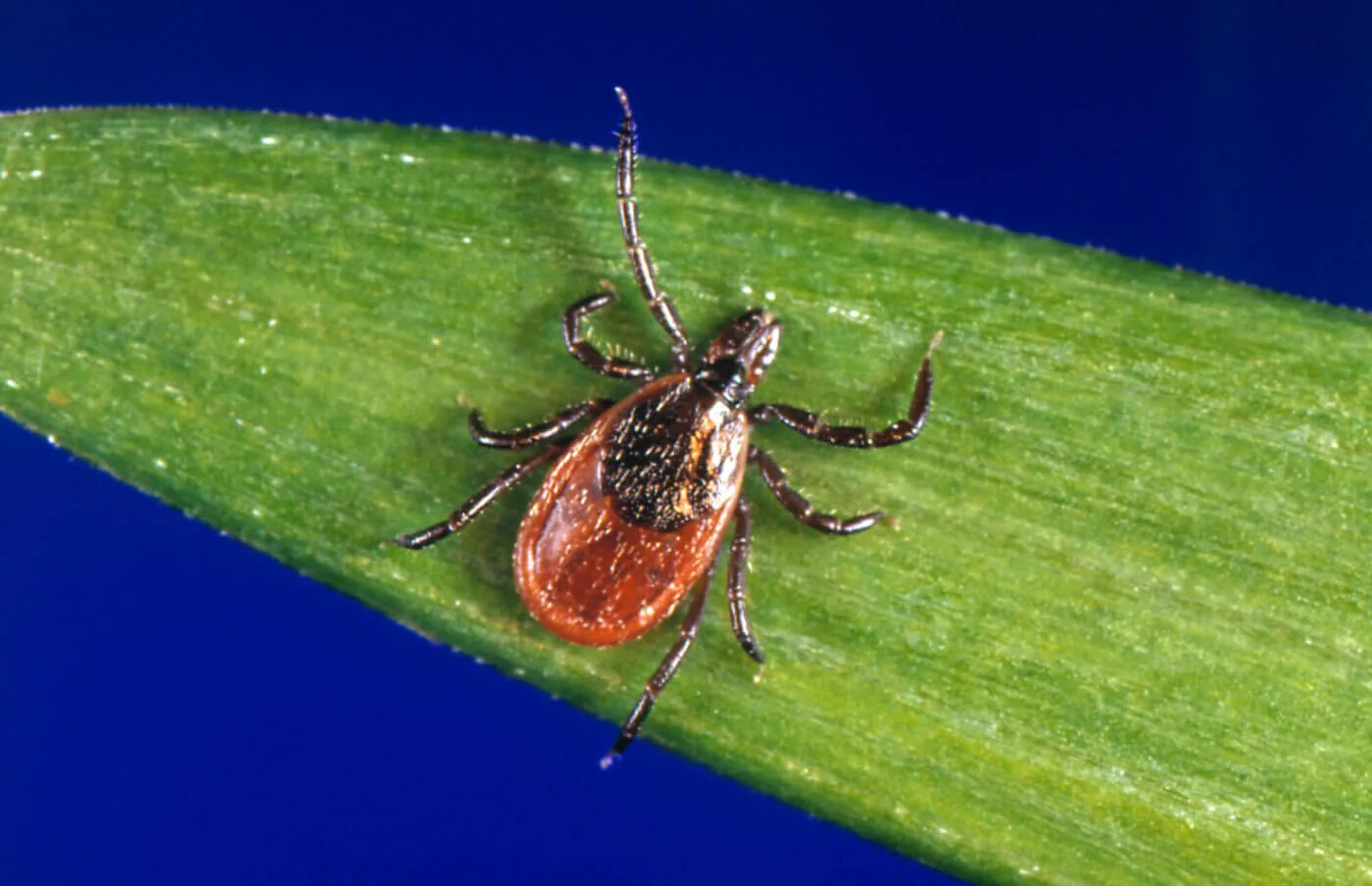
FILE - This undated photo provided by the U.S. Centers for Disease Control and Prevention (CDC) shows a blacklegged tick, which is also known as a deer tick. Ticks will be more active than usual early in spring 2023, and that means Lyme disease and other tick-borne infections could spread earlier and in greater numbers than in a typical year. Ticks can transmit multiple diseases that sicken humans, and deer ticks, which spread Lyme, are a day-to-day fact of life in the warm months in New England and the Midwest. (CDC via AP, File)
After a mild winter, there will likely be an uptick in ticks this year. Safeguarding yourself, and your pets, from ticks requires protecting yourself before, during, and after spending time outdoors.
Mild winters could mean more ticks earlier than usual and a wider spread of Lyme disease and other tick-borne diseases.
Tick season generally stretches from April to October, though Memorial Day is often considered the start of the season, largely because that’s when people in cold-weather states like Wisconsin ramp up their outdoor activity, leaving them more susceptible to tick bites.
Safeguarding yourself from ticks requires protecting yourself before, during, and after spending time outdoors.
“When you go out on a hike or spend time outdoors in a forest or recreational area, you definitely want to be mindful of ticks in those spaces,” Wesley Robinson, press secretary for the Pennsylvania Department of Conservation and Natural Resources, said.
“Cover exposed skin with lightweight, light-colored clothing, and avoid tick-infested habitats and areas with dense shrubbery and tall grass. We encourage people to use insect repellent to protect yourself from ticks before you run the risk of having one land on you and bite you. And always check for ticks after you get home. Check skin, hair, and clothing. Take a shower, wash your clothes and, if possible, dry all clothing in the dryer.”
Here’s everything Wisconsinites should know in order to survive tick season safely this year.
Where Are Ticks Most Commonly Found?
Wooded areas, grassy areas, and overgrown places that don’t have a lot of human development are the most common spots for ticks. While many associate those types of areas with more rural parts of the state, bigger cities and towns aren’t free of ticks.
“People think they’re not exposed to ticks in cities, but ticks can thrive almost anywhere where there’s woodlands, greenery and things like that,” Robinson said. Most of the time, ticks are going to be found on the ground, but they’re capable of climbing, which is how they get onto you, your kids, and your pets.
What Animals Carry Ticks?
Deer are one of the main carriers, but other animals can transmit ticks, especially those with longer hair, like horses and dogs, such as golden retrievers. That’s why watching pets in high-tick areas is so important, according to Robinson.
“You have a golden retriever that has a lot of fur, and it’s long enough to where something can get in and under and hide out,” Robinson said. “That can transmit and carry a tick and spread tick-borne disease with someone getting bit. It’s important to understand that lots of species are vulnerable to ticks and can carry ticks.”
What Happens When You Get a Tick Bite?
Infected ticks spread bacteria, viruses, and parasites that make people sick. Lyme disease is the most common tick-borne infection in the US, with an estimated 476,000 Americans diagnosed with Lyme each year, according to the Centers for Disease Control and Prevention.
The disease can cause a fever, chills, fatigue, and muscle and joint pain. It is treated with antibiotics, and most people recover. Left untreated, it can worsen, causing symptoms such as heart problems and debilitating pain. There is no Lyme vaccine on the market in the US for people but one is being tested.
However, ticks don’t only carry Lyme disease. Most tick-borne illnesses in Wisconsin are caused by the deer tick—for example, you can contract Borrelia mayonii from blacklegged ticks (a type of deer tick) in the state.
How Do You Know if You’ve Been Bitten by a Tick?
Tick bites typically aren’t painful, so you likely won’t feel it when it happens. Many times ticks will bite you and remain there.
The main sign of a tick bite, Robinson said, is that you’ll start to feel sick. A sudden rash, inflammation around the spot where you were bitten, chills, and fatigue are all prime indicators.
“If you notice something out of the ordinary, that’s probably a sign that you were bitten by a tick,” Robinson said. “If you were just in an overgrown area with lots of shrubs, there’s a great chance that there are ticks there. Operate under the assumption that if something does feel off, or you’re struggling with your health, they’re symptoms of a tick bite.”
What’s the Best Way to Check if Your Pet Has a Tick Bite?
If your cat or dog spends time in areas of heavy growth or high grass, they’re susceptible to tick bites.
Just like with people, Robinson said if your pet begins to act sluggish or is exhibiting symptoms of illness and they’ve just spent time in an area where tick presence is likely, assume they’ve been bitten.
“You want to do a full body check,” Robinson said. “Look for rashes or spots, bumps, and elevated areas. Some things you won’t be able to see, so you want to feel around for anything out of the ordinary. Because they cannot speak, you have to be a little more vigilant and diligent about seeing what’s going on.”
You can protect your pets with tick treatments and collars. Another way to protect them, Robinson said, is to keep them out of tick-infested areas.
“I think a lot of people get outdoors and think ‘I’ll let my pet roam free,’” Robinson said. “That’s all well and good, but the main thing is you want to make sure they stay safe and protected as well. Keeping them out of heavy, wooded areas during tick season is a good way to do that.”
What Should You Do if You’ve Been Bitten by a Tick?
If you do get bitten by a tick, use tweezers and grab it by the mouth from your skin. Then, submerge the tick in rubbing alcohol and flush it down the toilet. Clean and disinfect the area where you or your animal was bitten.
Symptoms of Lyme disease, and other tick-borne illnesses, can appear after the tick was removed. If you (or your pet) start to experience common symptoms, contact a medical professional right away.
“Because there are so many (tick-borne) diseases and people think of Lyme disease first, you might go to a doctor and say you got bit by a tick and they might treat you for Lyme disease and that might not be the best course of treatment,” Robinson said. Be diligent about your treatment to ensure everything is treated properly.
Information from the Associated Press was used in this story.
Politics

It’s official: Your boss has to give you time off to recover from childbirth or get an abortion
Originally published by The 19th In what could be a groundbreaking shift in American workplaces, most employees across the country will now have...

Trump says he’s pro-worker. His record says otherwise.
During his time on the campaign trail, Donald Trump has sought to refashion his record and image as being a pro-worker candidate—one that wants to...
Local News

Stop and smell these native Wisconsin flowers this Earth Day
Spring has sprung — and here in Wisconsin, the signs are everywhere! From warmer weather and longer days to birds returning to your backyard trees....

Your guide to the 2024 Blue Ox Music Festival in Eau Claire
Eau Claire and art go hand in hand. The city is home to a multitude of sculptures, murals, and music events — including several annual showcases,...




